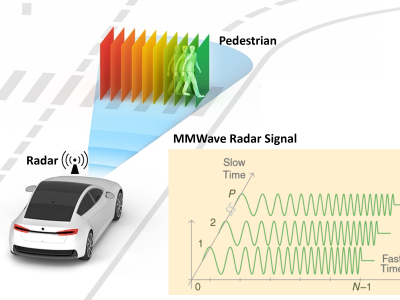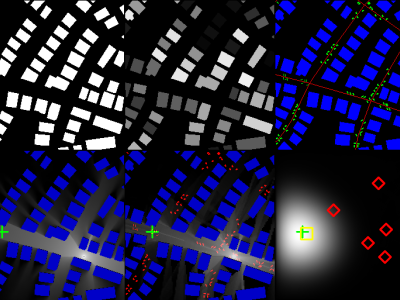CRAWDAD ucdavis/unitrans

- Citation Author(s):
-
Jason LeBrun (University of California, Davis)Chen-Nee Chuah (University of California, Davis)
- Submitted by:
- CRAWDAD Team
- Last updated:
- DOI:
- 10.15783/C75880
- Data Format:
 75 views
75 views
- Categories:
Abstract
This data set includes several traces about the available Bluetooth connectivity during a typical day on the Unitrans bus system at University of California, Davis.
date/time of measurement start: 2006-01-24
date/time of measurement end: 2006-03-03
collection environment: Wireless researchers have the problem of a lack of real-world mobility/connectivity data for doing simulation to evaluate various protocols, applications, and so on. The purpose of the experiment is to collect information about the available Bluetooth connectivity during a typical day on the Unitrans bus system at UC Davis.
network configuration: We equipped each bus with a small wireless sensor node (Intel iMote) to build a real public transit-centric network.
data collection methodology: We aimed to detect two buses that are close to each other, as well as any visible bluetooth devices that are used on the bus. Everytime an iMote sees another Bluetooth device (another iMote, or a cellphone/laptop/PDA with bluetooth capability), it logs the occurance, and for how long the other device was visible.
sanitization: MACs are anonymized using a consistent hashing scheme.
note: This data can also be found in SQLite3 database format, along with some Python tools for parsing the SQLite database. The tools are here: http://www.bluespotting.org/Projects/HaggleUnitrans
error: There were some fixes to the data from the raw data obtained from the iMote:
*Erroneous lines are omitted (if they don't contain 3 values)
*Corrupted MAC addresses are dropped
*Corrupted time values are dropped (less than 0)
*The time base is adjusted after a reset to try and keep it approximately the same.
*Corrupted MACs that ambiguously resolve to more than one mote are dropped
*Corrupted MACs that resolve to exactly one mote by flipping one or two bits are fixed and kept.
-Note: external device MACs may also be corrupted, but this is not accounted for.
Traceset
ucdavis/unitrans/imote
Bluetooth connectivity traceset collected on a bus system at UC Davis.
- file: unitrans.tar.gz
- description: We collected information about the available Bluetooth connectivity during a typical day on the Unitrans bus system at University of California, Davis.
- methodology: We collected real-world data using Intel iMotes, which contain an ARM core as well as a Bluetooth radio stack. The motes run a simple Bluetooth inquiry program. Periodocally (e.g., every 2 minutes) the device does an inquiry for a duration (e.g., 5 seconds). All devices detected during this inquiry period are noted. These experiments give a list of contacts - with start and end times - that a particular mote has during its lifetime. For each experiment, the polling interval was 2 minutes, and the inquiry duration was 5 seconds.
error: There were some fixes to the data from the raw data obtained from the iMote:
*Erroneous lines are omitted (if they don't contain 3 values)
*Corrupted MAC addresses are dropped
*Corrupted time values are dropped (less than 0)
*The time base is adjusted after a reset to try and keep it approximately the same.
*Corrupted MACs that ambiguously resolve to more than one mote are dropped
*Corrupted MACs that resolve to exactly one mote by flipping one or two bits are fixed and kept.
-Note: external device MACs may also be corrupted, but this is not accounted for.
ucdavis/unitrans/imote Traces
- Run1: Trace of Bluetooth sightings by a group of students carrying the motes at UC Davis.
- configuration: A student experiment that ran from Jan 24th, 2006 at 4:20pm until Jan 27th 2006 around noon. All of the students in a networking class carried the motes around during their day.
- format: The text files are named according the anonymized ID of the mote from which the data was collected. The format of the files is just a series of lines. Each line contains four values:
Information about the fields:
seen_vendor: vendor portion of MAC for the Bluetooth device seen in this contact.
seen_id: anonymized device portion for the Bluetooth device seen in this contact.
start: The start time for the contact (in seconds since boot)
end: The end time for the contact (in seconds since boot)
since_this: The amount of time passed since this mote last saw the device in this contact.
since_any: The amount of time passed since this mote saw *any* other device before this contact.
Some lines may contain all zeros. This indicates that a reset occurred between the previous line and the following line. The ramification of this is that for data collected after this time, we can no longer be sure about synchronization between this mote and the other motes.
- Run2: Trace of Bluetooth connectivity experiment on the Unitrans bus system at UC Davis.
- configuration: The first bus run, on Jan 30th, 2006 until Feb 3rd, 2006. Each bus in the UC Davis Unitrans system received one mote near the front of the bus. Many motes ran until the end of the week, although some were dead when we collected them back.
- format: The text files are named according the anonymized ID of the mote from which the data was collected. The format of the files is just a series of lines. Each line contains four values:
Information about the fields:
seen_vendor: vendor portion of MAC for the Bluetooth device seen in this contact.
seen_id: anonymized device portion for the Bluetooth device seen in this contact.
start: The start time for the contact (in seconds since boot)
end: The end time for the contact (in seconds since boot)
since_this: The amount of time passed since this mote last saw the device in this contact.
since_any: The amount of time passed since this mote saw *any* other device before this contact.
Some lines may contain all zeros. This indicates that a reset occurred between the previous line and the following line. The ramification of this is that for data collected after this time, we can no longer be sure about synchronization between this mote and the other motes.
- Run3: Trace of Bluetooth connectivity experiment on the Unitrans bus system at UC Davis.
- configuration: The second bus run, on Feb 27th, 2006 until March 3rd, 2006. An advertisement was placed on buses during this run, asking students to turn their Bluetooth radios on.
- format: The text files are named according the anonymized ID of the mote from which the data was collected. The format of the files is just a series of lines. Each line contains four values:
Information about the fields:
seen_vendor: vendor portion of MAC for the Bluetooth device seen in this contact.
seen_id: anonymized device portion for the Bluetooth device seen in this contact.
start: The start time for the contact (in seconds since boot)
end: The end time for the contact (in seconds since boot)
since_this: The amount of time passed since this mote last saw the device in this contact.
since_any: The amount of time passed since this mote saw *any* other device before this contact.
Some lines may contain all zeros. This indicates that a reset occurred between the previous line and the following line. The ramification of this is that for data collected after this time, we can no longer be sure about synchronization between this mote and the other motes.
Instructions:
The files in this directory are a CRAWDAD dataset hosted by IEEE DataPort.
About CRAWDAD: the Community Resource for Archiving Wireless Data At Dartmouth is a data resource for the research community interested in wireless networks and mobile computing.
CRAWDAD was founded at Dartmouth College in 2004, led by Tristan Henderson, David Kotz, and Chris McDonald. CRAWDAD datasets are hosted by IEEE DataPort as of November 2022.
Note: Please use the Data in an ethical and responsible way with the aim of doing no harm to any person or entity for the benefit of society at large. Please respect the privacy of any human subjects whose wireless-network activity is captured by the Data and comply with all applicable laws, including without limitation such applicable laws pertaining to the protection of personal information, security of data, and data breaches. Please do not apply, adapt or develop algorithms for the extraction of the true identity of users and other information of a personal nature, which might constitute personally identifiable information or protected health information under any such applicable laws. Do not publish or otherwise disclose to any other person or entity any information that constitutes personally identifiable information or protected health information under any such applicable laws derived from the Data through manual or automated techniques.
Please acknowledge the source of the Data in any publications or presentations reporting use of this Data.
Citation:
Jason LeBrun, Chen-Nee Chuah, ucdavis/unitrans, https://doi.org/10.15783/C75880 , Date: 20061101
















